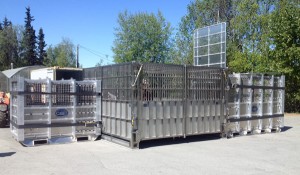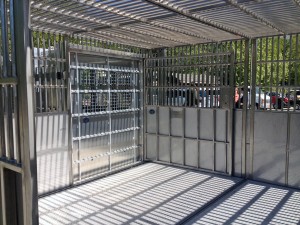
As companies look to expand oil and gas exploration in Alaska, many worry about the possibility of a spill and how wildlife – including polar bears – would be cared for. New equipment has given the U.S. Fish and Wildlife Service the capability to treat polar bears on the scene, which, until now, hasn’t been a possibility.
A large, stainless steel enclosure sits on display in the parking lot of the Alaska Zoo in Anchorage. Outwardly, it’s not terribly impressive; in many aspects, it looks like an over-sized dog kennel – if that kennel was designed to handle a fully grown, agitated polar bear.

“There’s two animal doors that access the transport crates, as you can see here,” Jerry Carter, the president of Carter 2 Systems – the company that designed the holding module, said. “And then one man door that we just came through – accessible by a key, spring-loaded, front and back, so you can lock the animal in or lock people out.”
The main enclosure is 12 feet wide and 12 feet long, with plenty of headroom for an adult human standing up. Flanking the holding module are two transport crates, which would hold the polar bear while in transit to the holding module from wherever it’s found.
Despite the enclosure’s rather large size, it can all fit into a standard-sized shipping container that you would see behind a semi-truck. Carter says the holding module actually collapses all the way from it’s full-sized 12 foot width, to less than two feet.
“When it collapses, the ceiling panels come down, floor panels come up, and then it collapses together like that,” he said.
This feature makes it easier to transport to wherever it’s needed. Susi Miller, a polar bear biologist with the U.S. Fish and Wildlife Service says that’s what makes this piece of equipment ideal.

“We wanted to have something that was relatively portable, that we could deploy in a field situation – like if you had a spill in a remote area, that all this equipment fits inside this conex, and you could take that conex via C-130 or cargo aircraft or barge, deploy it to a field site and treat bears more rapidly in the field,” Miller said.
The enclosure provides a space to clean oil from the bears and for veterinarians to observe and treat them, if necessary.
Miller says the holding module will likely just house one bear or possibly a family of bears – which would include a mother and small cubs. But, there are other situations where multiple bears could share the space.
“It does also allow us to treat adult males, or another scenario might involve sibling bears, second-year cubs or bears that are released from their mother, they’re no longer dependent on their mother, but they’re still hanging around together – we call them sub-adults,” Miller said. “You could potentially put two sub-adults together, but you wouldn’t put strange bears that weren’t related, non-related bears together.”
Once it’s broken down and packed into the conex, it will be shipped up to Deadhorse on the North Slope where it will be based out of.
Josh is the Statewide Morning News Reporter/Producer for Alaska Public Media | jedge (at) alaskapublic (dot) org | 907.550.8455 | About Josh




